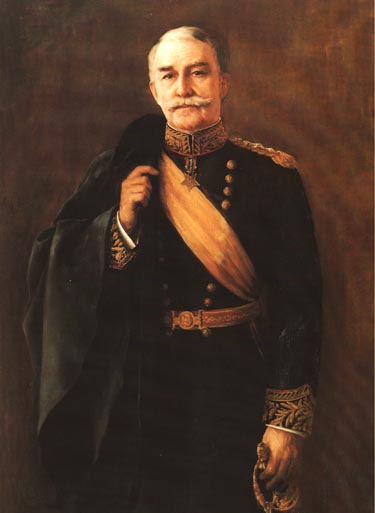
Nelson Appleton Miles was born on the family farm near Westminster, Massachusetts, on 8 August 1839; attended local schools and received rudimentary military instruction from a former French officer; recruited a company of volunteers and received a commission as captain, September 1861; served on General Oliver O. Howard’s staff and was wounded at the battle of Fair Oaks; was promoted to lieutenant colonel, 61st New York Volunteer Infantry, for gallantry in action, May 1862; replaced his seriously wounded commander at the battle of Antietam and was promoted to colonel, September 1862; was again wounded in the battle of Fredericksburg, 1862; was again wounded at the battle of Chancellorsville, 1863, where his gallant conduct later was recognized with the brevet of brigadier general (1867) and the Medal of Honor (1892); received the thanks of Congress for his conduct in the battles of the Wilderness and Spotsylvania, suffered slight wounds at the battle of Petersburg, and was appointed brigadier general of volunteers, May 1864; received his promotion to major general of volunteers, October 1865; commanded the District of Fort Monroe with supervision over Confederate President Jefferson Davis confined there; was appointed colonel in the regular establishment, July 1866; commanded the District of North Carolina during Reconstruction, 1866–1867; married General Sherman’s niece, Mary Hoyt Sherman, 1868; served in the frontier Indian wars, participating importantly in operations against Central Plains tribes, 1869–1874, and Northern Plains tribes, 1874–1880; commanded the Department of the Columbia, 1880–1884; commanded the Department of the Missouri, 1885–1886; commanded the Department of Arizona, 1886–1887, bringing the Apache Wars to a close; commanded the Division of the Pacific, 1888–1889; commanded the Division of the Missouri, 1889–1894, with overall responsibility for operations at Wounded Knee and in the Pullman Strike; was commanding general of the United States Army, 5 October 1895–8 August 1903; represented the United States at the Queen Victoria Jubilee Celebration, was an observer of Turco-Grecian War operations, and attended the maneuvers of the Russian, German, and French armies, 1897, observed operations in Cuba and conducted the campaign in Puerto Rico in the War with Spain, 1898; was advanced to three-star rank under the provisions of a 6 June 1900 act that specified the senior major general of the line commanding the Army shall have the rank, pay and allowances of a lieutenant general; was promoted to permanent lieutenant general, February 1901; visited the Philippines, the Far East, and Europe, 1902; retired from active service, August 1903; was the author of three books published in 1896, 1897, and 1911; died in Washington, D.C., on 15 May 1925.
The Artist
Caroline Thurber (1864–1950) was born in Oberlin, Ohio, and was reared and educated in Philadelphia. She studied in Italy, Germany, and England, and received some of her art training in Paris under Jean Paul Laurens and Benjamin Constant. Around the turn of the century she exhibited at the Royal Academy in London and the Paris Salon. Although her early subjects were children, she turned later to portraits of prominent individuals in the professions. In addition to her portrait of General Miles, she painted Governor Lucius Garvin of Rhode Island, Supreme Court justices of several states, and President Elizabeth Storrs Meade of Mount Holyoke College. Her portrait of General Nelson A. Miles hangs in the United States Army Military History Institute at Carlisle Barracks, Pennsylvania.
Nelson Appleton Miles
By Caroline Thurber
Oil on canvas, 58" x 40", 1903
[88]

page updated 30 April 2001
Return to the Table of Contents